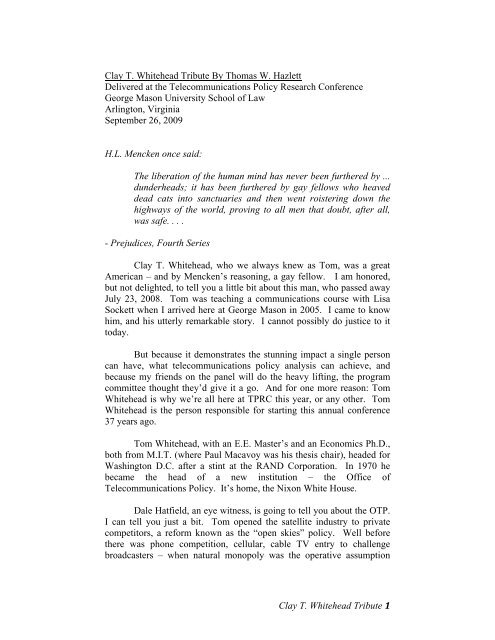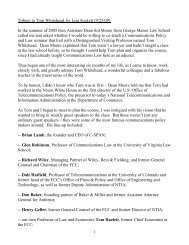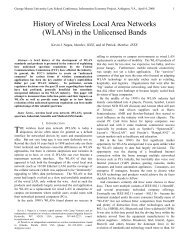Clay T. Whitehead Tribute by Thomas W. Hazlett - Information ...
Clay T. Whitehead Tribute by Thomas W. Hazlett - Information ...
Clay T. Whitehead Tribute by Thomas W. Hazlett - Information ...
- No tags were found...
Create successful ePaper yourself
Turn your PDF publications into a flip-book with our unique Google optimized e-Paper software.
<strong>Clay</strong> T. <strong>Whitehead</strong> <strong>Tribute</strong> By <strong>Thomas</strong> W. <strong>Hazlett</strong>Delivered at the Telecommunications Policy Research ConferenceGeorge Mason University School of LawArlington, VirginiaSeptember 26, 2009H.L. Mencken once said:The liberation of the human mind has never been furthered <strong>by</strong> ...dunderheads; it has been furthered <strong>by</strong> gay fellows who heaveddead cats into sanctuaries and then went roistering down thehighways of the world, proving to all men that doubt, after all,was safe. . . .- Prejudices, Fourth Series<strong>Clay</strong> T. <strong>Whitehead</strong>, who we always knew as Tom, was a greatAmerican – and <strong>by</strong> Mencken’s reasoning, a gay fellow. I am honored,but not delighted, to tell you a little bit about this man, who passed awayJuly 23, 2008. Tom was teaching a communications course with LisaSockett when I arrived here at George Mason in 2005. I came to knowhim, and his utterly remarkable story. I cannot possibly do justice to ittoday.But because it demonstrates the stunning impact a single personcan have, what telecommunications policy analysis can achieve, andbecause my friends on the panel will do the heavy lifting, the programcommittee thought they’d give it a go. And for one more reason: Tom<strong>Whitehead</strong> is why we’re all here at TPRC this year, or any other. Tom<strong>Whitehead</strong> is the person responsible for starting this annual conference37 years ago.Tom <strong>Whitehead</strong>, with an E.E. Master’s and an Economics Ph.D.,both from M.I.T. (where Paul Macavoy was his thesis chair), headed forWashington D.C. after a stint at the RAND Corporation. In 1970 hebecame the head of a new institution – the Office ofTelecommunications Policy. It’s home, the Nixon White House.Dale Hatfield, an eye witness, is going to tell you about the OTP.I can tell you just a bit. Tom opened the satellite industry to privatecompetitors, a reform known as the “open skies” policy. Well beforethere was phone competition, cellular, cable TV entry to challengebroadcasters – when natural monopoly was the operative assumption<strong>Clay</strong> T. <strong>Whitehead</strong> <strong>Tribute</strong> 1
everywhere in the sector – and particularly so in the high fixed costsatellite industry – Tom <strong>Whitehead</strong> developed, pushed, and won FCCadoption of rules to permit multiple firms to offer satellitecommunications. That was huge. It created the means for cable TVprogram network distribution; competition was soon unleashed tobroadcasting. Voice and data services were next. More importantly, itestablished the idea that monopoly was not inevitable. Competition wasa bargain. The dead cat had been tossed.Tom <strong>Whitehead</strong> was then instrumental in breaking up AT&T.David Gabel, whose father worked with tom, filled in fascinating detailsfor me just last night. When the antitrust case had been teed up <strong>by</strong> theUS DOJ, Secretary of Treasury George Schultz told the White House, “Ifyou’re going to file the suit, please hold off until the Treasury gets pastits next T-Bill sale. AT&T was floating more debt than the U.S.government, and the suite would roil markets. Tom <strong>Whitehead</strong> sawthings with a new clarity – if the U.S. government had to tip toe aroundMa Bell, maybe it was time to act. Tom, with the telecom policyportfolio, gave the high sign: the suit would go forward.Leaving government, Tom went on to a spectacular career as anentrepreneur, founding a subdivision of Hughes that revolutionized cablenetwork distribution, slashing costs for systems and programmers. Then,in 1985, he launched satellite services from Luxembourg that broke openthe tightly controlled European video market. Today SES Astra servesover 120 million households, scores of cable TV systems, and haspartners all over the world. Open skies have circled the planet.What more could Tom do? Well, this whimsical engineereconomistproudly challenged – and overturned – an 1892 District ofColumbia law that banned kite flying in Washington. And then he didsomething truly important. Tom <strong>Whitehead</strong> created theTelecommunications Policy Research Conference in 1972. I give youthe story as told <strong>by</strong> Bruce Owen, now of Stanford, then an economistworking for Tom at OTP:TPRC got started in 1971 because Tom <strong>Whitehead</strong> requested andreceived a $2 million budget for "research" at OTP. Then heasked me to help find ways to spend the money.It was necessary to spend the money because otherwise OMB orCongress might not give us the same amount next year. It isremarkably difficult to find responsible and risk-free ways tospend $2 million of research funds, or at any rate so it was back<strong>Clay</strong> T. <strong>Whitehead</strong> <strong>Tribute</strong> 2
in 1971. We found several projects that could be and were done<strong>by</strong> "beltway bandits." The results were not uplifting.Each of the research contractors kept asking what result wewanted them to find. We explained to them that, if we knew theanswers, it would not be necessary to do the research. Thecontractors were asea. Finally, they did their best to guess whatanswers we wanted and sent in their reports.Tom asked whether there was not a better approach. I told himthat academic researchers might do better, at least in coming upwith their own answers, but that academic researchers oftenfound it difficult to produce useful research in response to shorttermcontracts. Tom suggested that we should explain out needsto researchers, and listen to what they were working on, andperhaps that would make it easier to spend this money in thefuture.And so TPRC was established, essentially, as a way to spendresearch money more responsibly. Just don't ask how Tom cameup with the $2 million figure for the research budget in the firstplace.INTRO: Lisa Sockett.INTRO: Margaret <strong>Whitehead</strong>.INTRO: Dale Hatfield.CLOSING: Tom <strong>Hazlett</strong>.Bruce M. OwenStanford University: Gordon Cain Senior Fellow,Stanford Institute for Economic Policy Research;Morris M. Doyle Centennial Professor in Public PolicyBrian Lamb, the founder and CEO of C-SPAN, among the firstbasic cable networks, and a man who worked with Tom <strong>Whitehead</strong> at theOTP, describes the situation this way:Just to give you an idea, in those days, if I needed time to get toall the cable systems in the United States it would have cost, wefigured, about 15 million dollars [an hour] for me to have a<strong>Clay</strong> T. <strong>Whitehead</strong> <strong>Tribute</strong> 3
transmission system that I would buy from AT&T – that wasabout your only choice – to get to all these cable systems.[That was the effect of COMSAT – the sole authorized U.S.satellite service, 50% owned <strong>by</strong> AT&T. Lamb notes that thecable industry was stifled <strong>by</strong> this monopoly bottleneck. The wayout began when FCC Chairman] Rosel Hyde said to Tom<strong>Whitehead</strong> – a 31 year old guy talking to a guy twice his age –“We want to launch a domestic satellite system and we want tomake it a single entity. We want to get everybody together in onelittle company – ABC, NBC, CBS, Hughes, RCA, AT&T – alltogether and we’ll form a board and all that stuff the same as withCOMSTAT, and we’ll have one company launching the satellitesand we’ll get on with it,” Tom, at that age, said “Huh uh. That isthe dumbest thing ever. This country is a competitive country, acompetitive environment, and the marketplace decides.” Hesingle-handedly, with all the people that he worked with, puttogether a policy called Open Skies. Without Open Skies, wewould not have been a network.Open Skies was proposed <strong>by</strong> the White House to the Chairman ofthe FCC, Dave Birch, who took over after Rosel Hyde left, andthey adopted the Open Skies policy… Western Union put up thefirst domestic satellite in April of 1974; RCA put up a satellitethat began operating in 1975; Hughes Corporation; GTE [] putone up – there were six in the beginning. . . . Six is a pretty goodnumber. . . . I could buy [at] 100 dollars an hour. But if youngTom <strong>Whitehead</strong> hadn’t come along and said, at the point whenRosel Hyde, who was a Republican and should have been amarketplace guy at the time – you can see how labels get turnedupside down in this town. . . . [I]f Tom hadn’t been there, no oneelse was paying attention in the White House.Brian LambFounder and CEO of C-SPANYes, Tom was paying attention to the details, and yet never lostsight of the grand strategy of policy reform. It wasn’t a game to him. Hewas a future that eluded so many others, and was just brave and craftyenough to get there.A visionary who challenged the monopoly model in thesanctuary, who spoke truth to power, Tom <strong>Whitehead</strong> truly shiftedparadigms, and then went roistering down the highways of the world,<strong>Clay</strong> T. <strong>Whitehead</strong> <strong>Tribute</strong> 4
literally launching disruptive technologies that proved to all mankindthat doubt, after all, was safe, and delivered really cool new services.My deepest gratitude goes to Tom <strong>Whitehead</strong> for that amazingcontribution. And, <strong>by</strong> the way, for TPRC. My deep appreciation rightnow goes to my colleague Lisa Sockett, and to long-time friend DaleHatfield, who has himself mentored so many scholars in this room andaround the world. Their wonderful remembrances are very special. Iespecially whish to thank Margaret <strong>Whitehead</strong> for picking up the baton,working tirelessly to make Tom’s treasure trove of insight and historicaldocumentation of the telecommunications policy process available forserious academic research.This concludes our session.<strong>Clay</strong> T. <strong>Whitehead</strong> <strong>Tribute</strong> 5




